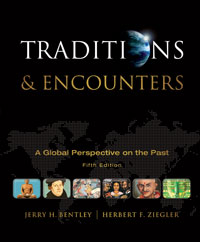
Traditions and Encounters, AP Edition (Bentley), 5th EditionChapter 16: The Two Worlds of ChristendomOverviewAfter the fall of the Roman empire, two very different realms of European Christendom emerged. In the east, the Byzantine empire managed to flourish politically, economically, and socially. In contrast, western Europe's economy underwent a sharp constriction, and early medieval Europe was a world dominated by rural self-sufficiency and political decentralization. The differences in the two societies also manifested in the ritual and doctrinal differences between the two Christian communities that culminated in a schism between the eastern and western churches that exists to the present day. Several unique features of the Byzantine civilization contributed to its prosperity:
While other parts of the world were experiencing unprecedented prosperity during the postclassical era, Europe was laying the foundation for the development of the powerful society that would emerge during the high middle ages. That foundation rested on the following:
During this period Roman Christianity provided the impetus for cultural continuity and unity in western Europe. The office of the papacy and the monastic movement were two powerful institutions that helped to preserve Roman traditions and develop and consolidate a uniquely European culture. |  |















